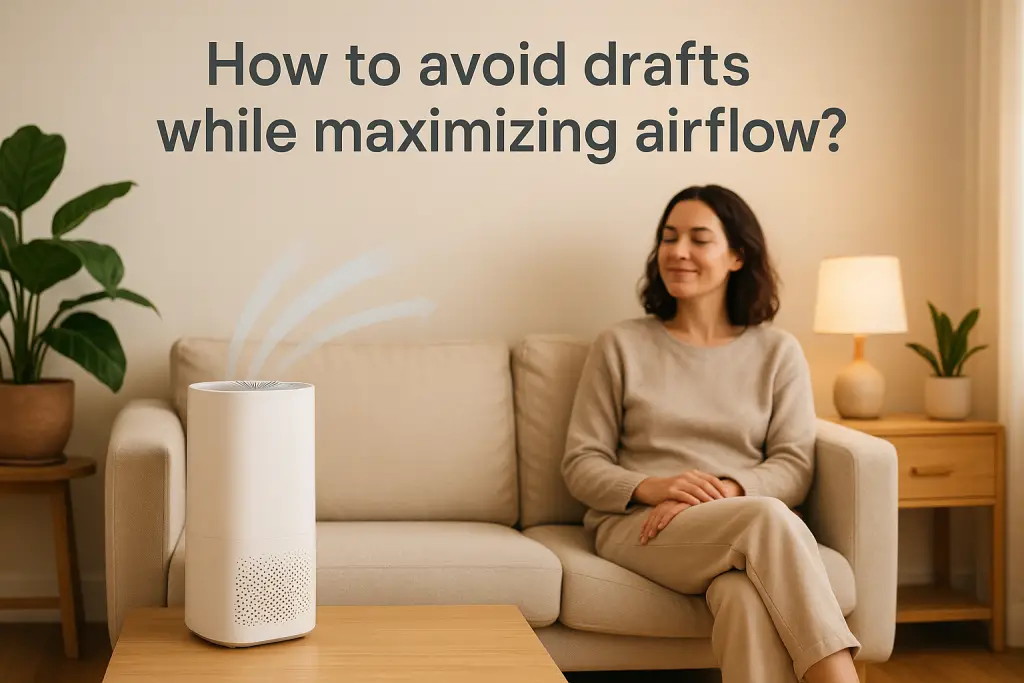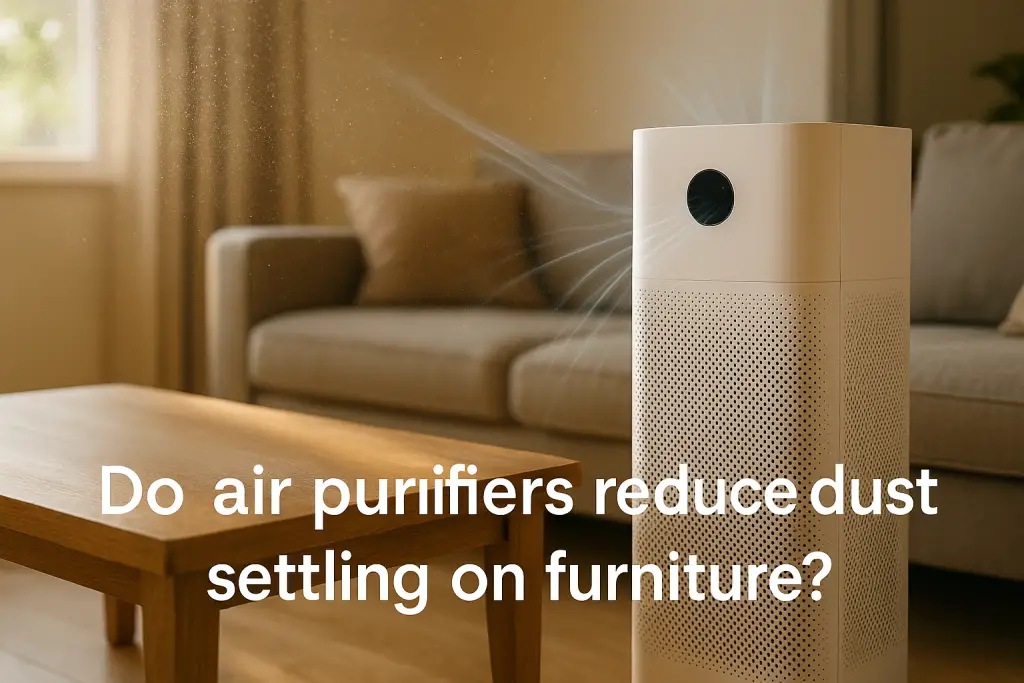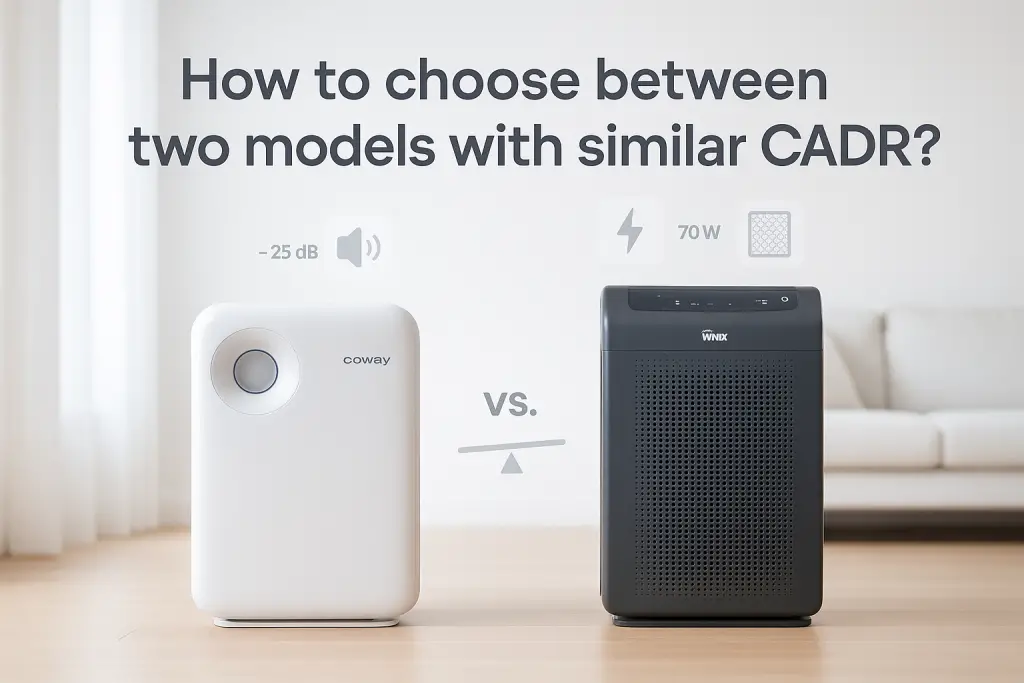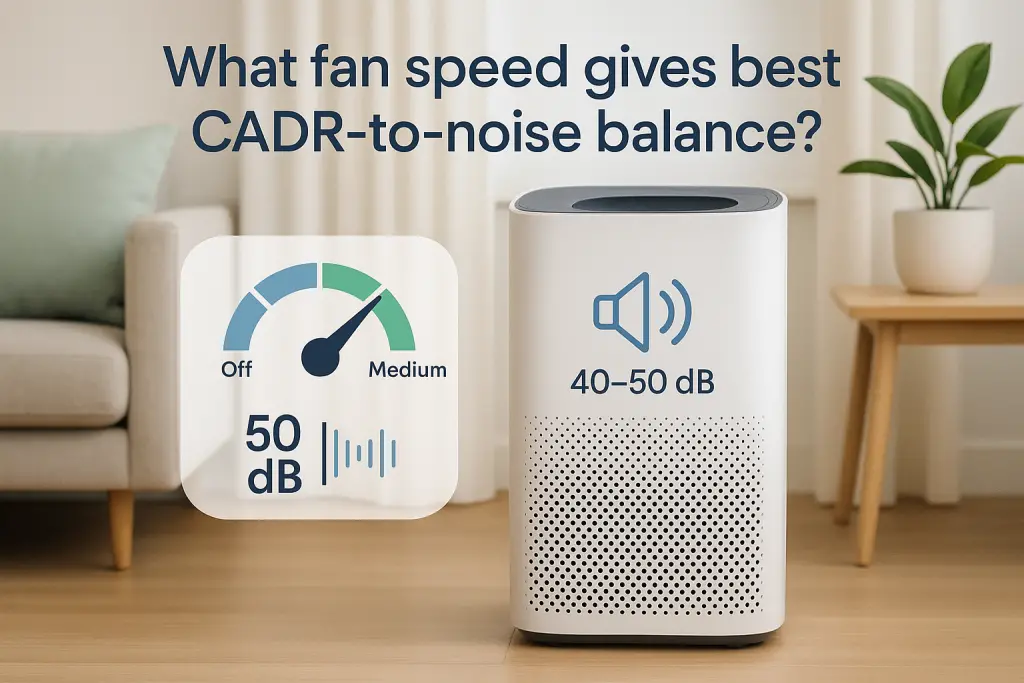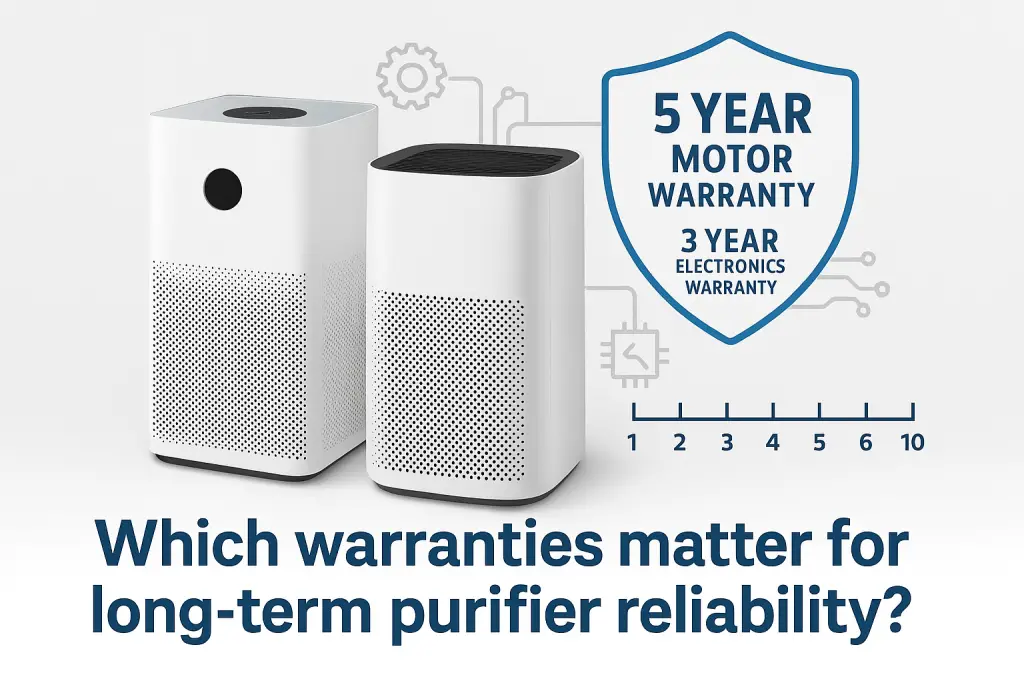Balancing airflow with comfort can be challenging when using air purifiers. The goal is to clean your indoor air effectively without creating uncomfortable cold drafts. This comprehensive guide provides practical solutions to eliminate drafts while ensuring your air purifier works efficiently. By understanding airflow dynamics and implementing strategic placement, you can enjoy clean air without feeling like you’re sitting in a wind tunnel.
What Causes Drafts from Air Purifiers?
Air purifiers clean air by pulling it through filters and pushing it back into your room. This creates air movement which can feel like drafts. Drafts happen when moving air is cooler than your skin temperature or moves too quickly across your body. Unlike gentle air circulation, drafts feel uncomfortable and can cause discomfort, especially for those sensitive to temperature changes.
According to the American Society of Heating, Refrigerating and Air-Conditioning Engineers (ASHRAE), air moving faster than 0.8 feet per second can create noticeable drafts. Most air purifiers push air at 2-5 feet per second at their output vents, which explains why they often create that “drafty” feeling.
Key factors that contribute to draft sensation include:
- Fan speed settings on the air purifier
- Distance between you and the air purifier
- Direction of airflow relative to your position
- Room temperature compared to the moving air
- Individual sensitivity to moving air
How to Assess Your Draft Situation
Before implementing solutions, identify exactly where and why drafts are occurring in your space:
Simple Draft Detection Tests
- Tissue test: Place facial tissues around your room while the air purifier runs. Watch for movement to identify airflow patterns.
- Temperature mapping: Use a digital thermometer to measure temperatures in different parts of your room. Look for cooler spots that align with airflow paths.
- Smoke pencil observation: Use a smoke pencil (available at hardware stores) to visualize how air moves from your purifier throughout the space.
Once you understand your specific situation, you can select the most effective strategies for your space. Rectangular rooms require specific airflow patterns to achieve optimal air circulation without creating uncomfortable drafts.
Optimal Air Purifier Placement to Minimize Drafts
Where you place your air purifier significantly impacts both its effectiveness and draft creation. Follow these placement guidelines for draft-free operation:
General Placement Rules
- Height matters: Place air purifiers 3-5 feet off the ground for better air distribution. This prevents concentrated streams of air at sitting or sleeping level.
- Distance from walls: Keep units at least 6-12 inches from walls to allow proper air intake and prevent concentrated outflow.
- Avoid direct paths: Never place the air purifier output directly facing seating or sleeping areas.
- Use corners strategically: Corner placement can help diffuse airflow across multiple walls before it reaches you.
- Consider cross-breezes: Position your purifier to work with, not against, natural air currents in your home.
Room-Specific Placement Tips
Different rooms require different placement strategies:
Bedroom placement: Position the air purifier at least 6 feet from your bed, with the output facing away from where you sleep. Ideally, place it on the opposite side of the room from your bed. For smaller bedrooms, place it in a corner with the output facing the center of the room.
Living room placement: Position the unit away from seating areas, ideally behind furniture like a sofa. This creates a buffer between you and direct airflow. Proper living room seating arrangements can significantly impact both air quality and comfort by managing airflow patterns throughout the space.
Office placement: Place the purifier perpendicular to your workspace rather than facing you directly. Position it at least 4 feet from your desk, preferably to the side rather than directly in front or behind you.
Technical Adjustments to Reduce Drafts
Beyond placement, adjusting your air purifier’s settings can significantly reduce draft sensation while maintaining cleaning efficiency:
Speed Settings and Timing Strategies
- Use medium settings: Running your purifier on medium rather than high can reduce draft sensation by 40-60% while still providing 80-90% of the air cleaning benefits.
- Auto mode utilization: Most modern air purifiers have auto modes that adjust fan speed based on air quality. This prevents unnecessary high speeds when air is already clean.
- Schedule high speeds strategically: Run your purifier on high when you’re not in the room, then switch to lower settings when you’re present.
- Night mode benefits: Use night mode not just for reduced noise but also for gentler airflow that minimizes drafts while you sleep.
Maintenance for Optimal Performance
Regular maintenance ensures your air purifier runs efficiently without creating unnecessary drafts:
- Clean pre-filters weekly to maintain proper airflow
- Replace main filters according to manufacturer guidelines
- Keep intake and output vents dust-free
- Check for any obstructions that could redirect airflow
It’s important to use genuine replacement filters for optimal performance. Avoiding counterfeit replacement filters ensures your air purifier maintains proper airflow and efficiency, which helps prevent the need to run it at higher, draft-creating speeds.
Supplementary Solutions to Diffuse Airflow
When placement and settings adjustments aren’t enough, try these additional approaches to diffuse concentrated airflow:
DIY Air Deflectors
Create simple air deflectors to redirect and diffuse concentrated airflow:
- Basic deflector: Position a small piece of cardboard at a 45-degree angle above the output vent to redirect air upward where it can mix with room air before descending.
- Mesh screen diffuser: Attach a fine mesh screen several inches away from the output vent to break up direct airflow into multiple smaller streams.
- Perforated shield: Create a curved shield with multiple small holes from a file folder or thin plastic sheet. Position it 6-8 inches from the output vent.
Strategic Furniture Placement
Use furniture to create buffers between you and direct airflow:
- Position bookshelves or tall plants to intercept and diffuse airflow
- Use open-backed furniture that allows air to pass through gradually
- Create indirect paths for air to travel through the room before reaching you
How to Avoid Drafts While Maximizing Airflow for Sensitive Individuals
Some people have greater sensitivity to air movement due to age, health conditions, or personal preference. For these individuals, special considerations are necessary:
For Elderly or Temperature-Sensitive Individuals
- Use the lowest effective fan setting
- Place units even farther from seating areas (minimum 8 feet)
- Consider timer operation to provide periods without air movement
- Add a thin deflection screen to disperse airflow more widely
- Monitor room temperature carefully, keeping it slightly warmer to offset cooling from air movement
Those with allergies or respiratory conditions often need special air purification approaches. Specialized protocols for allergies and asthma can help balance the need for thorough air cleaning with comfort considerations.
For Children’s Rooms
- Never place air purifiers where airflow directly contacts a child’s bed or play area
- Position units higher up (on dressers or shelves) with airflow directed toward the ceiling
- Use the gentlest settings that still provide adequate filtration
- Consider models with more diffused output designs
Selecting Draft-Minimizing Air Purifiers
If you’re shopping for a new air purifier, certain features and designs can help minimize drafts:
Draft-Friendly Design Features
- 360-degree discharge: Units that release air in all directions spread airflow more evenly and reduce concentrated streams.
- Top-discharge models: Purifiers that release air upward create less noticeable drafts at sitting level.
- Wide-angle output: Look for models with wider output vents that naturally diffuse air over a larger area.
- Smart sensors: Units with occupancy sensors can adjust airflow based on room usage.
- Adjustable louvers: Some models allow you to direct airflow precisely where you want it.
When selecting an air purifier, make sure to choose the right size for your space. Determining the appropriate air purifier size for your room ensures it can clean effectively without running at excessive speeds that create drafts.
Integrating Air Purifiers with Existing HVAC Systems
Coordinating your air purifier with your home’s existing air systems can create better overall circulation with fewer drafts:
Coordination Strategies
- HVAC fan operation: Run your HVAC fan periodically (even without heating/cooling) to help distribute purified air throughout your space.
- Return vent positioning: Place air purifiers near return vents when your HVAC is running to help distribute cleaned air.
- Ceiling fan cooperation: Use ceiling fans on the lowest setting to gently mix air without creating additional drafts.
- Seasonal adjustments: In winter, reverse ceiling fans to pull air up rather than push it down, reducing draft sensation.
Poor indoor air quality can lead to various health issues that might not be immediately obvious. Headaches and fatigue could be related to indoor air quality issues rather than drafts, so it’s important to maintain effective air purification while addressing comfort concerns.
Measuring Air Purifier Effectiveness Without Drafts
After implementing your draft reduction strategies, verify that your air purifier is still effectively cleaning your air:
Monitoring Methods
- Air quality monitors: Use portable monitors to track particulate matter levels before and after your adjustments.
- Dust accumulation test: Place clean black surfaces in various room locations and compare dust accumulation over time.
- Smell test: Odors should still be noticeably reduced despite lower fan speeds or redirection.
- Allergy symptom tracking: Note any changes in allergy symptoms after making adjustments.
A properly functioning air purifier should still show measurable improvements in air quality even with draft-reducing adjustments. Air purifiers have proven effectiveness for removing dust and pollen when set up correctly, even with modifications to minimize drafts.
Creating Your Personal Draft-Free Air Purification Plan
Combine the strategies from this guide to create a customized approach for your specific situation:
- Assess your space: Identify current draft patterns and problem areas
- Optimize placement: Reposition your air purifier based on room-specific guidelines
- Adjust settings: Find the lowest effective fan speed for your air quality needs
- Add diffusion: Implement deflectors or barriers if needed
- Coordinate systems: Synchronize operation with your home’s other air systems
- Verify results: Check both comfort levels and air quality measurements
- Make seasonal adjustments: Plan for different needs throughout the year
Conclusion: Balancing Air Quality and Comfort
Creating a draft-free environment while maintaining effective air purification is entirely possible with the right approach. By understanding the physics of airflow, strategically placing your air purifier, making appropriate technical adjustments, and implementing supplementary solutions when needed, you can enjoy clean, healthy air without uncomfortable drafts. Remember that balance is key, and you may need to adjust your approach seasonally or as your needs change.
Apply these strategies methodically, measure your results, and enjoy the benefits of clean air without the discomfort of drafts. Your perfect balance of air quality and comfort is achievable with these expert-backed techniques.
| Photo | Air Purifier Model | Best for | Price |
|---|---|---|---|

|
WINIX A231 Air Purifier | Asthma & Indoor Pollution | Check Price On Amazon |

|
Rabbit Air, A3 SPA-1000N Air Purifier | Pet Dander & Odors | Check Price On Amazon |

|
LEVOIT Air Purifier | Best Overall | Check Price On Amazon |

|
GermGuardian Air Purifier | Cigarette & Cooking Smoke | Check Price On Amazon |

|
Coway Airmega Air Purifier | New-borns | Check Price On Amazon |

|
BLUEAIR Air Purifier | Germ & Virus Control | Check Price On Amazon |
